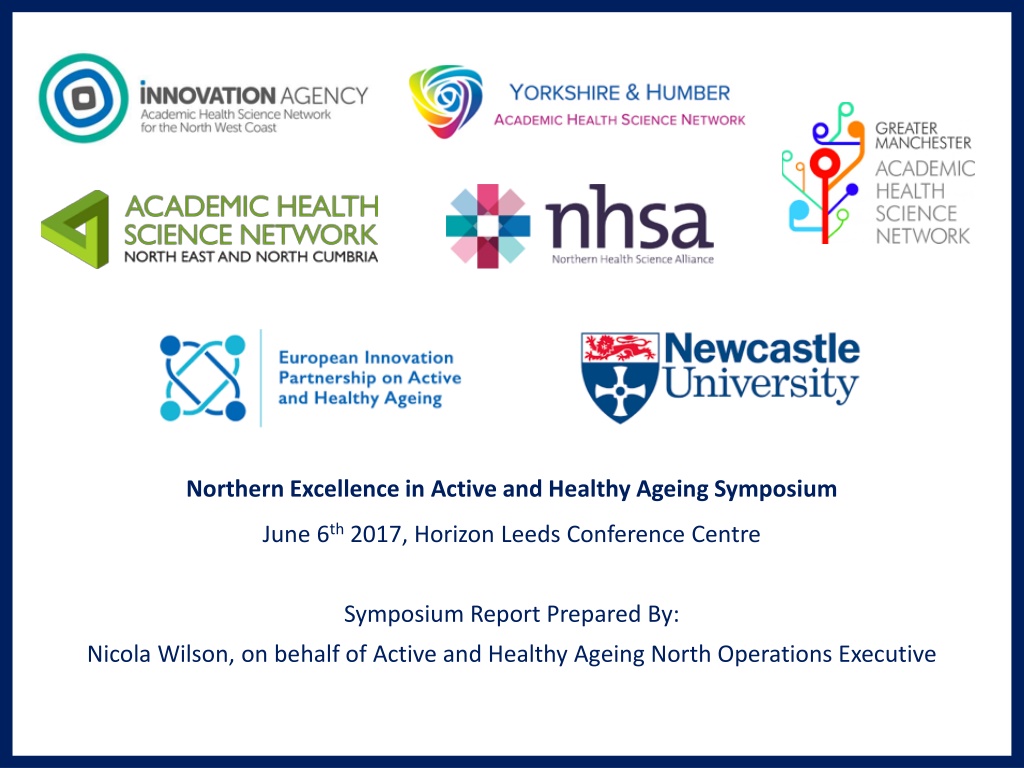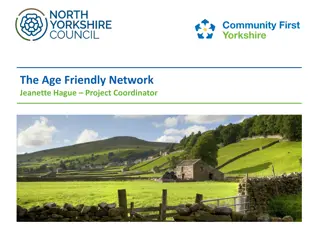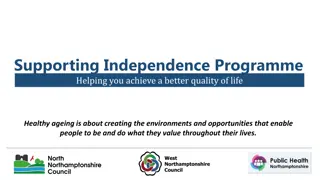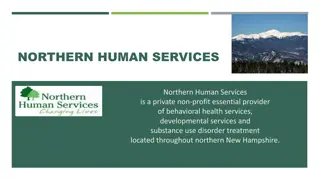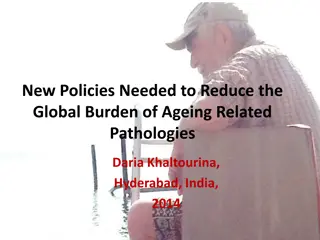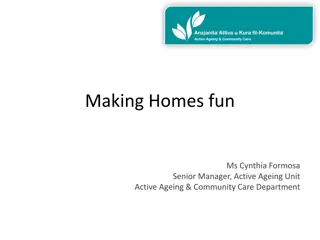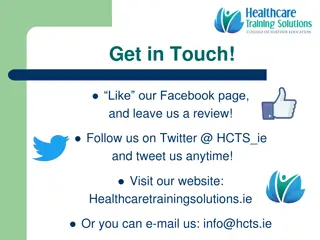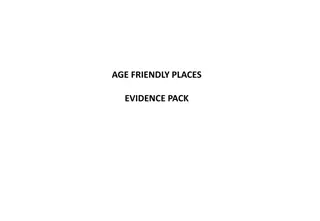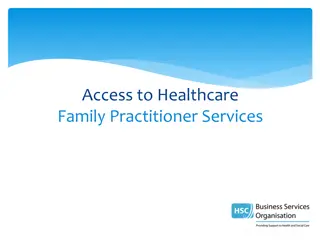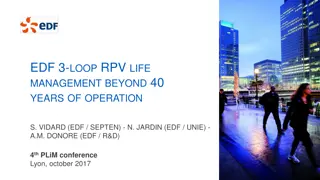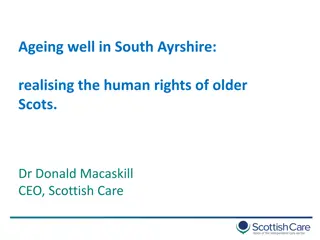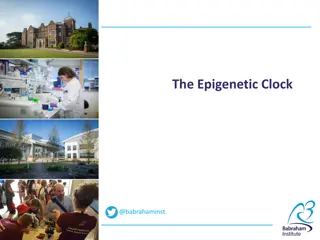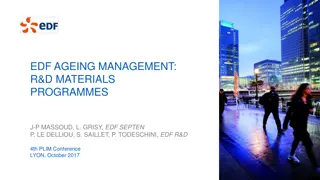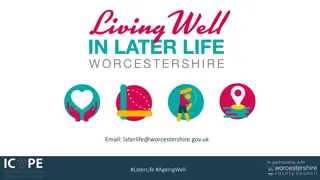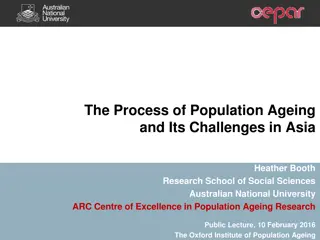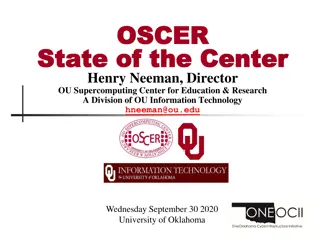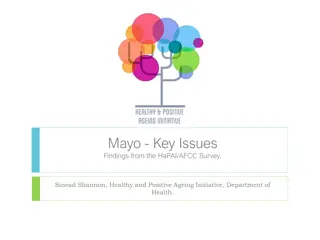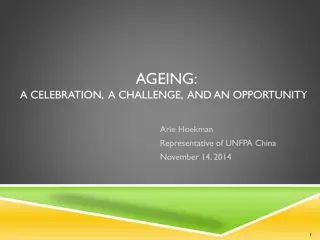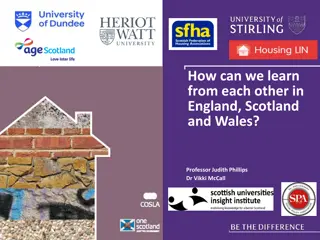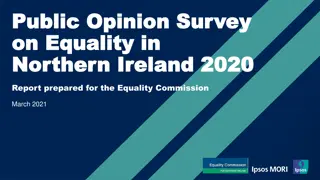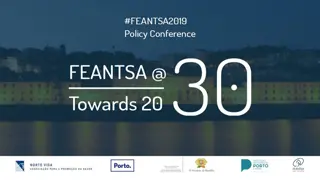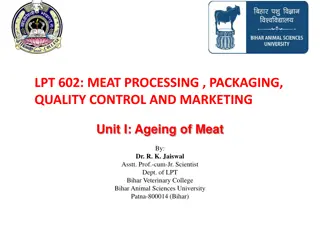Northern Excellence in Active and Healthy Ageing Symposium Report
The symposium report highlights the successful initiatives and collaborations aimed at promoting active and healthy ageing in the North of England. Key figures like Professor Martin Vernon and Dr. Hakim Yadi commend the innovative efforts to improve care for the ageing population. The report emphasizes the urgency to support older adults in maintaining health and independence. With a focus on addressing long-term conditions and promoting healthy ageing, the collaborative efforts of various organizations are paving the way for positive changes in healthcare.
Download Presentation

Please find below an Image/Link to download the presentation.
The content on the website is provided AS IS for your information and personal use only. It may not be sold, licensed, or shared on other websites without obtaining consent from the author. Download presentation by click this link. If you encounter any issues during the download, it is possible that the publisher has removed the file from their server.
E N D
Presentation Transcript
Northern Excellence in Active and Healthy Ageing Symposium June 6th 2017, Horizon Leeds Conference Centre Symposium Report Prepared By: Nicola Wilson, on behalf of Active and Healthy Ageing North Operations Executive
Contents and Acknowledgements 1. Titles 2. Contents and Acknowledgements 3. Foreword: Professor Martin Vernon, NHS England 4. Foreword: Dr Hakim Yadi, OBE, The NHSA 5. Foreword: Richard Stubbs, Yorkshire and Humber AHSN 6. Section One: Setting the Scene 7. Photograph: AHA North Operations Executive 8. Section Two: Who Attended 9. Photograph: Symposium Chair and Selection of Speakers 10.Infographic: Ideas Cloud 11.Section Three: What Took Place 12.Section Four: Conclusions and Next Steps 13.Appendix A: Dashboard: Roundtable Feedback by Theme Page 1 Page 2 Page 3 Page 5 Page 6 Page 8 Page 10 Page 11 Page 12 Page 13 Page 14 Page 25 Page 27 Acknowledgements: The Author wishes to extend her grateful thanks and appreciation to colleagues on the AHA North Operations Executive for their input to and feedback throughout the process of writing this report. Similarly, particular thanks to Shirley Hannan (the NHSA) and Tom Lindley (TRL Healthcare Innovation) for their ideas on how to bring the report to life, visually, and to her CEO, Dr Hakim Yadi, for dedicating NHSA resource to support this crucial programme of work. Finally, very special thanks to all those who gave up their time to attend the Symposium and for your energy and ideas that you brought with you. Nicola Wilson, July 2017 2
Foreword: Professor Martin Vernon, National Clinical Director for Older Adults, NHS England We are indeed living in challenging times. Yet over the last year, working for NHS England as National Clinical Director for Older People, I have been both privileged and impressed by the enthusiasm, ingenuity and commitment to hard work going on around the country focused on improving care and outcomes for our ageing population. As a health and care system collectively we have much to be proud of. Ageing European Partnership. remarkable based on our successful innovation in this area to date. through the Innovation A achievement truly Of course there is much more to do if we are to drive up care quality and outcomes both now and for future generations. People aged over 85 represent one of the fastest growing segments of the population and soon in the UK a fifth of the population will be over the aged of 65. As a result, the country s health and care systems are facing considerable challenges as we strive to meet the needs of the most vulnerable people in our society. It was the work of these innovative alongside the Health Science Alliance that organisations Northern pulled the symposium together to not only showcase what has been achieved already but to set a direction for future and accelerated progress in Active Healthy Ageing. There is an urgent requirement to ensure that we support our older population to stay as healthy, active and independent as possible through the effective management of the long-term conditions, which accompany us into later life. Whether it be through the adoption and spread of the award winning electronic Frailty Index (eFI), through Bone Health programmes, the fantastic Steady On! Initiative, the work taking place by The Greater Manchester Ageing Hub, or any of the other examples profiled on that day, we know that delivering change to improve people s lives is what really makes the difference. The innovative and creative work by these organisations over the last few years has enabled great strides to be taken in addressing the real issues that challenge the NHS and the populations we serve across the country. It is encouraging to see that we have also worked actively and productively with partners and other agencies across Europe. What comes next through joint working across the North of England, under the umbrella of a combined AHA Strategy, has the potential to improve the day- to-day lives of millions of people. Prevention of unwarranted variation and promotion of healthy ageing are always going to be key to this. Through my role with NHS England, I ve been delighted with the progress being made across the country, which addresses the Active Healthy Ageing agenda, particularly in relation to the innovations showcased by the Northern Academic Health Science Networks and the Northern Health Science Alliance. In 2016 through their coordinated bids, the entire North of England was awarded 3* Reference Site Status in Active Healthy 3
Foreword: Professor Martin Vernon, National Clinical Director for Older Adults, NHS England I cannot think of a greater ambition in this field than to improve the experience of ageing for populations throughout the country; the North is leading the way in this for England. The symposium represented a fantastic positive step - this report is another significant step forward. I commend it to you and hope that this important work continues to progress well so we can bring about positive and enduring change in Active Healthy Ageing for our future generations. Professor Martin Vernon National Clinical Director for Older Adults, NHS England 4
Foreword: Dr Hakim Yadi, OBE, CEO of the Northern Health Science Alliance (NHSA) The North s expertise in active and healthy ageing is second to none, with centres of international excellence located across the region. Last year, the outputs from a rigourous assessment process by a panel of independent experts from across Europe demonstrated that not only is the North leading the way on helping people live fuller and more active lives but is also leading on health research and innovation in ageing. These two activities combined mean we have the potential to make a very real difference to millions of people s lives. The Northern Health Science Alliance (NHSA) has supported our member organisations in the North East, North West Coast, Greater Manchester and Yorkshire and Humber areas throughout the AHA Reference Site application process last year, and more recently to realise a much-needed coordinated alignment,and is proud to be an on-going partner in the Active and Healthy Ageing North (AHA North) programme of activity that has been created. Dr Hakim Yadi OBE CEO of the Northern Health Science Alliance (NHSA) 5
Foreword: Richard Stubbs, CEO, Yorkshire and Humber AHSN Many of us are familiar with the story of our growing ageing population. People aged over 85 are the fastest growing part of the population. In the next fifteen years one fifth of the population will be over 65. However, we often miss the important nuances of our growing ageing population. The World Health Organisation s (WHO) Misconceptions on Ageing and Health highlights many of these. For instance, expenditure on older populations and on encouraging everyone to age well, the report argues, is not a cost but a high-return investment. In the report s words, these investments can yield significant dividends, both in the health and well-being of older people and for society as a whole through increased participation, consumption and social cohesion. It is clear that strong leadership is necessary to form a comprehensive, innovation-based approach to active and healthy ageing across many sectors. In 2013, Yorkshire and the Humber became one of the first regions in England to be awarded three-star European Reference Site Status for Active and Healthy Ageing. The European Reference Sites are coalitions of regions, cities, integrated hospitals or care organisations, industry organisation, SMEs and research institutions that jointly aim to provide concrete examples of innovative services with proven added value to citizens and care systems in EU regions. All Reference Sites have committed to sharing their achievements with others and transferring knowledge across Europe. The Yorkshire & Humber AHSN led the latest successful bid on behalf of all stakeholders in the region to retain our international recognition for the region s active and healthy 6
Foreword: Richard Stubbs, CEO, Yorkshire and Humber AHSN ageing initiatives. Following this, I was delighted to chair the Active Healthy Ageing Symposium along with our colleagues from the other three Northern AHSNs and the Northern Health Science Alliance, who hosted the event. The symposium shared the best practice taking place across the North of England, the basis for all of the North of England being awarded Reference Site status. We were delighted that Professor Martin Vernon, National Clinical Director for NHS England for Older People and Person Centred Integrated Care, could join us at the conference. The symposium was a clear statement of our ambition as a region to meet this challenge head on, and to capitalise on the incredible and impactful work that is being delivered across the North. The energy on the day was positive proof that we have a huge opportunity to make a fundamental difference in this extremely important agenda. Richard Stubbs CEO, Yorkshire and Humber AHSN 7
Section One: Setting the Scene, what is an Active and Healthy Ageing Reference Site? In January 2016, a valuable opportunity arose placing excellence in Active and Healthy Ageing (AHA), taking place across the North of England, on a European platform. Additionally, this opportunity afforded the creation of a structured collaboration and alignment in older adult health between the four North of England Academic Health Science Networks (AHSNs) - Greater Manchester AHSN, The Innovation Agency (North West Coast AHSN), North East Coalition for Active and Healthy Ageing, and Yorkshire & Humber AHSN. All four applications were successful, and in December 2016 the four organisations received international recognition for their excellence in active and healthy ageing, at a ceremony within the European Summit on Digital Innovation for Active and Healthy Ageing in Brussels. In total, 74 regional and local organisations across Europe were awarded "Reference Site" status at the ceremony. Their collaborative approach in engaging health and care providers, government, industry and researchers in the development and adoption of innovative solutions have helped to improve health and care outcomes for patients, and offered new models and approaches that will help transform the way services are delivered. This recognition along with the technological and innovative solutions being developed will help to open new commercial markets across Europe and beyond. This opportunity arose in the shape of the North of England AHSNs being given strategic guidance from the Northern Health Science Alliance (NHSA) to apply for ReferenceSite status in the 2nd Call from the European Innovation Partnership on Active and Healthy Ageing (EIP-AHA). This alignment ensured each organisation could contribute their individual expertise at local- level, whilst offering a similar but different narrative in their suitability for trans-Northern joined up capabilities, in addition to the trans-European collaboration expected of AHA Reference Sites. (John Farrell, Strategic Adviser to The Reference Site Collaborative Network, July 2016) A Reference Site is defined by the European Commission as: Whilst in Brussels, the NHSA and the four Northern AHSNs met to scope a new programme of collaboration in older people s health, ultimately joining forces in their wealth of expertise particularly regarding frailty and falls prevention. The NHSA committed to support and offer strategic alignment to the four AHA ReferenceSite organisations and an Active and Healthy Ageing North (AHA North) Operations Executive was created, chaired by Richard Stubbs (CEO of the Yorkshire & Humber AHSN), to guide the collaborative programme, which whilst still in its infancy provides valuable and much needed support to: Ecosystems which comprise different players (including regional and/or local government authorities, cities, hospitals/care organisations, industry, SMEs and/or start-ups, research and innovation organisations and civil society), that jointly implement a comprehensive, innovation-based approach to active and healthy ageing, and can give evidence and concrete illustrations of the impact of such approaches on the ground . 1 8 1https://ec.europa.eu/eip/ageing/reference-sites_en
Section One: Setting the Scene, what is an Active and Healthy Ageing Reference Site? NHS England s 5 Year Forward View national strategy, and with additional alignment, to parts of HM Government s Life Sciences Strategy due for publication during the summer of 2017. One of the first objectives the AHA North Operation Executive set itself was to deliver a showcase of what is already happening in the field, whilst also drawing on how Northern expertise aligns with national, UK and European policy and strategy in ageing health and wellbeing. The Northern Excellence in Active and Healthy Ageing Symposium took place on June 6th 2017 in Leeds, and this report has been created to provide the reader a comprehensive understanding of what took place on the day from the AHA North Operations Executive perspective and will conclude with the tangible next steps we seek to take. What is our ambition? 1. Ours is a huge challenge that can only be met through collaboration and creativity. 2. The North is leading the way (as our collaborative and creative Symposium demonstrated). 3. We re only just getting started. So, please watch this space for more to come. In the mean time, we have two questions for the attendee reader: As a sense check, have we got this write-up right and does our account and experience mirror yours? Are we on the right track to realise our aspirations? Any feedback would be gratefully received by Nicola.Wilson@thenhsa.co.uk 9
AHA North Operations Executive Ops Exec placeholder Left to Right: Amanda Risino (GM), Dai Roberts (GM), Andy Shakeshaft (NWC), Richard Stubbs (Chair, Y&H), Graham Armitage (NE), Steve Stericker (Y&H&), Kirstie Clegg (GM), Nicki Wilson (the NHSA) 10
Section Two: Who Attended? Richard Stubbs, CEO of Yorkshire & Humber AHSN and Chair of the AHA North Operations Executive chaired the Symposium, and invited attendees were strategically targeted for their stakeholder opinion. Significant discussion and attendee mapping was undertaken by the AHA North Operations Executive to ensure that the right people would be in the room to sense check the ideas and aspirations of a trans-Northern programme of delivery. The sectors represented on the day included NHS England GPs and CCG Commissioners Provider Trusts Local Authority Commissioners and Public Health Leads University and Research Institutions Third Sector and Charitable Organisations Industry and SME A full list of registrants and attendees can be viewed here. 11
Northern Excellence in AHA Symposium Chair and a Selection of Speakers Speakers picture placeholder Left to Right: Richard Stubbs (Chair), Elaine Colgan (NI), Abi Phillips (Wales), Donna Henderson (Scotland), Professor Oliver James (NE), Dr Sarah De Biase (Y&H), Professor Martin Vernon (NHS England), Professor Maddalena Illario (Campania, Italy) and Dr Hakim Yadi, OBE, (The NHSA) 12
The Smallest Ideas Can Take Us a Long Way Ideas Cloud Ideas Cloud Increase use of community assets such as 'men in sheds' Ideas Cloud Age as a 'meaningless' characteristic. Ageing is flexible and malleable It isn't about ageing but how we lead our lives, there is a real need for conversations in their own environment. We need a two-way dialogue between the practitioner and the service user, and there is an opportunity to use tech/digital for this to support people to change behaviours.
Section Three: What took place? This section of the report provides the reader with an overview of the day s agenda and activity. The speakers slides can be viewed here, and their biographies can be viewed here. Prevention of Frailty and Functional Decline of the European Partnership on Active and Healthy Ageing, and additionally sits on the coordination team of A3 Action Group s Area of Food and Nutrition. Since 2013, she has coordinated Campania Reference Site activity within the European Partnership on Active and Healthy Ageing. Welcome Address Richard Stubbs, CEO, Yorkshire & Humber Academic Health Science Network Keynote 2: Aligning Northern Collaboration in AHA with NHS England Priorities in eFrailty and Frailty Indexing Professor Martin Vernon Richard is the Chief Executive Officer of the Yorkshire & Humber Academic Health Science Network (AHSN), an organisation that connects NHS, academia and industry to facilitate change across whole health and social care economies, with a focus on increasing economic growth and improving outcomes for patients. Previously, Richard was a core member of the NHS National Leadership Council, and has acute and commissioning senior management experience. He joined the NHS from the BBC as a graduate trainee, and is also an alumnus of the NHS Top Leaders and NHS BreakingThrough programmes. Martin qualified in 1988 in Manchester. Following training in the North West, he moved to East London to train in Geriatric Medicine where he also acquired an MA in Medical Ethics and Law from King s College. He returned to Manchester in 1999 to take up post as Consultant Geriatrician, building community geriatrics services in South Manchester. In 2015, Martin moved to Central Manchester where he is Consultant Geriatrician and Associate Head of Division for Medicine and Community Services. He also holds Honorary Academic Posts at Manchester and Salford Universities and was appointed as Visiting Professor at the University of Chester in 2016. In 2016, Martin was appointed National Clinical Director for Older People and Person Centred Integrated Care at NHS England. Keynote 1: Campania s Experience in the European Innovation Partnership on Active and Health Ageing (EIP- AHA) Professor Maddalena Illario Northern AHA Exemplar Practice, Yorkshire & Humber Dr Sarah De Biase Since December 2016, Maddalena has coordinated the Campania Region Division on Health Innovation. Maddalena previously coordinated the Research and Development Unit of Federico II University Hospital as well as managing the Italian team of the PERRSILAA and Sympathy participation in the Sunfrail Project. Since May 2015, she has been a Promoter (expert) for the A3 Action Group on Sarah is the Programme Manager for the Healthy Ageing Collaborative, a network established to support the development and evaluation of new evidence-based models of care for people with frailty. Cross cutting the Yorkshire & Humber AHSN s projects, and Campania s 14
Section Three: What took place? Healthy Ageing and Connected Bradford (part of Connected Health Cities) programmes, Sarah leads a portfolio of projects designed to test the clinical utility of the electronic Frailty Index (eFI) and engage primary care clinicians to use the eFI to proactively identify, diagnose and manage frailty. Programme. The programme uses a population-based approach to assess routine GP practice data to identify patients at risk of fracture across the North East and North Cumbria. The Bone Health initiative looks at identifying 'at risk' patients at GP practice level and starts them on the correct patient pathway in line with local and national guidance. Interventions include education/information for patients on a healthier lifestyle, medication compliance, medication initiation or change. Supporting increased implementation of the eFI throughout the region has the potential to make significant improvements to the health of local people living with frailty. The index is recommended in the national GMS GP frailty contract which will support primary care across England to identify the estimated 3% of patients at risk of severe frailty registered with every GP practice across the country to receive individually tailored assessment, support and case management. Better targeted and proactive care for people living with frailty has the potential to reduce demand on non- elective care services and produce savings across local health economies. "The Bone Health Programme in collaboration with Clinical Commissioning Groups and General Practices, supported by the AHSN-NENC, and in partnership with Interface Clinical Services and pharmaceutical companies, provides a wonderful example of a collaborative way of working in which patients benefit enormously by reducing their risk of hip and fragility fractures, while there is a likely large financial saving to the NHS. We are extending this to benefit patients as widely as possible throughout the North East and North Cumbria and beyond! Dr Sarah De Biase, Programme Manager, Yorkshire & Humber Healthy Ageing Collaborative "Professor Oliver James, Medical Director, Academic Health Science Network for the North East and North Cumbria. Northern AHA Exemplar Practice, North East Professor Oliver James Raising the Bar: How a Good Reference Site in AHA becomes Better Donna Henderson, Elaine Colgan and Abigail Phillips Professor James, FMedSci, was a Consultant Physician in Newcastle for 30 years, Professor of Medicine from 1985, Head of Newcastle University School of Clinical Medical Sciences from 1995, Pro Vice Chancellor Medical Faculty 2004- 2008. He was Senior Vice President Royal College of Physicians 1997-1999 and has authored over 300 papers on aspects of liver disease and ageing. Professor James presented the AHSN NENC Bone Health Our valued colleagues from the AHA Reference Sites of Scotland, Northern Ireland and Wales respectively gave us an insight into their local level exemplar and award winning expertise in older people s healthcare, and helped us understand how good can become better. 15
Section Three: What took place? As Head of European Engagement at the Scottish Centre for Telehealth and Telecare (SCTT), Donna Henderson leads NHS 24 s European Engagement Team, which aims to enhance Scotland's reputation as a leader in digital health and care and promote economic opportunities for Scotland, on behalf of the Scottish Government. Donna has been a lead Co-ordinator of the European Innovation Partnership on Active and Health Ageing B3 Action Group on Integrated Care - the largest of the 6 EIP on AHA Action Groups since 2012. Ireland 4* Reference Site, European engagement, Ireland. This includes the further development of the Northern Ireland 4* Reference Site, European engagement, and management of structural funding on behalf of the Department. Elaine is treasurer of the Reference Site Collaboration Network. Abigail Phillips currently heads up the healthcare technology programme overseeing multiple key work streams including the Efficiency through Technology Fund, SBRI Healthcare and the establishment of the technology assessment and adoption function, Health Technology Wales. Prior to working in the Welsh Government Health and Social Services Group, Abigail held positions in Finance and Economy Departments as well as a board position at a local charity supporting vulnerable individuals and their families. Elaine Colgan has recently taken on the role of Head of eHealth and European Branch in the Department for Health in Northern Ireland. This includes the further development of the Northern "For Northern Ireland, one of the important factors as we look to the future is being able to test our innovations and scale up successful improvements. This is made easier by our joined up approach to active and healthy ageing, involving partners in academia, business, our Department for Economy, and involving user co-design when we consider our future services. This collaboration was key to achieving 4* status and demonstrating the quadruple helix approach. Our unique system of integrated health and social care facilitates a joined-up, person-centred approach to care and assists with trialling and scaling up of innovative solutions, which coupled with our NI Electronic Care Record a single secure web- based regional clinical portal creates a flow of patient information across health and social care leading to enhanced quality, safety and efficiency of care and practice." "Wales is continuing to build on the activity which got us to 4* recognition of the value of partnerships in the UK beyond, using alternative funding models for innovation grants, industry partnerships, procurement increasing the use of outcome data to drive system improvements." mechanisms and Abigail Phillips, Head of Healthcare Technology Programme, Welsh Government. Morning Speakers Panel Q&A Chaired by Dr Hakim Yadi, OBE Hakim is CEO of the Northern Health Science Alliance Ltd (NHSA). He led the formation of the NHSA, bringing together 20 NHSA members across the North of England securing over 60m in contracts and raising the profile of the North s health research. Elaine Colgan, Head of ehealth and European Branch, Department of Health, Northern Ireland. 16
Section Three: What took place? Previously, Hakim co-managed the translational medicine team at PA Consulting Group and was seconded to the UK Government as Chief Operations Officer and was a founding member of the Department of International Trade Life Sciences Organisation. He is co-founder of two women s healthcare companies and is co- founder of the Global Heart Network. HY: Regarding individual interventions versus population health challenge, how do we articulate? How do we develop strong narrative to convey? Professor Oliver James (OJ): Start with the GP federations. Find the lead clinicians and enthusiasts to champion. Now that our objectives are known, we are talking to CCGs more. It is down to talks with individual practices. Use local media to encourage patients to ask GP what they re entitled to. Hakim acted as the Q&A Chair and invited all speakers from the morning sessions back to the stage. Most questions were taken from the audience. Answers below are summarised and not verbatim. Professor Martin Vernon (MV): It is a case of needs versus wants. Address needs of individuals within communities versus wants of population. Agree on the need for a narrative to align two things. The narrative should incentivise people to live well and engage in what s happening around them. There should be a successful health and social care system plus interventions based on need. Give people back ownership of their own care when able. Question from the Chair, Dr Hakim Yadi (HY): Ageing and staying well are not solely dependent on health system function but also a societal civic challenge. Do you consider that you have the right partners in place? If not, how best do you build relationships? Professor Maddalena Illario (MI): University hospitals are proven in their expertise and add value to partnerships. Support must also include local stakeholders. We have found some non-profit organisations difficult to engage but they ultimately can translate approaches in a swifter and easier to adopt way. MI: The social isolation aspect is an important driver. Involving older adults in any decision-making process helps adoption. Follow where they go rather than inviting them somewhere else. Donna Henderson (DH): We look to provide funding to Scottish voluntary and community services to encourage cross-sectoral relationship building. Question from the Floor: What are the holistic benefits? OJ: I agree on the importance of evaluation (e.g., models used in Ireland). Try to do more health economics. Increase the sense of empowerment to all staff in practices/prevention services. Elaine Colgan (EC): It is vital to have Clinicians on board; however, the challenge is that they all work in their own individual ways. 17
Section Three: What took place? cancer/dementia narratives. It s important to improve communication skills what benefits and why, and how can we organise your care around you? Question from the Floor: To what extent are housing providers, planning departments, environment, culture etc. included in this thinking? MI: We use self-assessment tools around adherence to diet, which in turn empowers the person. Abigail Phillips (AP): Wales has Housing Association involvement, but there is more work to do. The Welsh government is very interested in remote monitoring to support independence at home. ..has commissioning run it s course? DH: Tech enabled care is key, with some of most innovative solutions led by our Housing Associations. The D4 action group of the European Innovation Partnership on Active and Healthy Ageing has an Age Friendly Environment focus to feed in broader environmental impacts, also feeding into digital cities work. Question from the floor to Professor Martin Vernon: Demand reduction by increasing prevention. PBR/tariff results in challenges getting into prevention. Has commissioning run its course? MV: No, of course it hasn t. There is a need to take different approaches, think about what we are commissioning and why. There is a civic duty re value for money in health and social care commissioning and delivery. New models, like RightCare, iron out variation across the country, which is important. We need to maintain an agile, flexible and astute approach to commissioning. Prevention question partly re commissioning but also responsibilities for provider organisations to engage with the commissioning processes. Creating headroom for large provider organisation places duty on them to reinvest. We need productive dialogue between commissioners and providers: with falls being a good example. It needs to be assertive, evidence based, diligent. Question from the Floor: How to sell to end users? Language such as #frailty #falls is not popular. Is there a user-friendly chart/pathway for users and families? Dr Sarah De Biase (SDB): Using health-checks for over 75 year olds. Frailty nurses are using PRISMA7 for self-reporting. Resources such as these are used alongside discussions with clinicians to measure resilience and ability to cope. MV: There is a blog on the NHS England website. We work with Age UK for a sounding board approach with older people regarding what frailty means. We are starting to embed this into the NHS England narrative regarding routinely identifying frailty. The purpose is to create opportunities for people. We need to sell the benefits of using the tool, similar to the 18
Section Three: What took place? Question from the Floor: We could be better at listening to older people. We need to empower and skill up volunteers. GPs need more info on community assets. How can we listen, influence and get older residents more involved? EC: Northern Ireland has a legal requirement / top down approach with Age friendly subgroups for our prevention agenda. MV: Community is the answer. Public messaging at a local level. Understanding inter-generational relationships. Show potential gains, e.g., Wigan s clear offer from Public Health to local community, positive engagement. Question from the Floor: To what extent are housing providers, planning departments, environment, culture etc. included in this thinking? Question from the Floor: Process for sharing at pace and scale - Is there an ideal model? AP: Even with funding, it is difficult to change practice. Therefore, there is a need for engagement, negotiating and influencing. Command and control is a last resort. We use dedicated networks to share best practice. However, it depends on the aspirations and motivations of an organisation. DH: Agree. E.g., the mastermind project, online CBT. GPs are keen to access projects such as these due to KPIs. Attend anywhere model e.g., Australian virtual clinic for GPs which is a low-cost solution and easy to integrate. GPs can see where patients are requesting to be seen virtually. There is a compelling need for GPs to adopt this. Any low tech, easy to use option should support rather than give more work. 19
Section Three: What took place? The Greater Manchester Ageing Hub has an ambition for Greater Manchester to be the first age-friendly city region in the UK, to be a global centre of excellence for ageing, and to increase economic participation among the over-50s. Strong partnerships in Greater Manchester will be pivotal to realising these ambitions, including close working with the Mayoral team and nationally with the Centre for Ageing Better (CfAB). Northern AHA Exemplar Practice, North West Coast Sumaiya Sufi and Yvonne Skellern-Foster Sumaiya is a quality improvement and safety specialist for residential settings. She manages a team of contract monitoring officers and quality improvement coordinators who work with providers to ensure they meet contractual obligations and provide safe, quality care. As well as working individually with providers, Sumaiya is responsible for developing good practice guidance, tools and processes that support quality improvement in residential settings. Falls are a consistent concern for residential providers and STEADY On! Provides an opportunity for staff, residents, family and friends to address the issue in a simple and practical way. Chris is Professor of Primary Care and Community Health, School of Health Sciences, University of Manchester. He leads the Healthy Ageing Research Group with a major theme of falls prevention and activity promotion amongst older people, including the use of technologies in support of interventions. He leads the pan-European ProFouND falls prevention network and is a member of the leadership group of the EIP-AHA Action Group 2 on falls prevention. He works with the Greater Manchester Ageing Hub providing expertise on evidence based interventions to achieve the Hub s strategic goals in the areas of activity promotion and falls prevention. As FALLS Team Partnership Lead at East Lancashire Teaching Hospitals NHS Trust, Yvonne is an accident prevention practitioner both in Children s and Older Peoples Falls prevention. For the last 17 years, she has been a key member of two multi-award winning innovative prevention services. She currently leads the East Lancashire STEADY Team. North West Coast and Greater Manchester Exemplar Practice Q&A: Chaired by Nicki Wilson Northern AHA Exemplar Practice, Greater Manchester Paul McGarry and Professor Chris Todd Nicki is the Operations Manager at the NHSA and served as the Q&A Chair. She invited all speakers from the previous two sessions back to the stage, and questions were taken from the audience. Answers below are summarised and not verbatim. Paul has led Manchester s multi-agency urban ageing partnership, now known as Age-Friendly Manchester, since 2003. The partnership works across public, private and community sectors, and with residents, to improve the quality of life of Mancunians in mid and later life. In 2017, Paul was appointed as the Head of the Greater Manchester Ageing Hub, which he worked with partners to set up over the previous twelve months. Comment from the Floor: Comment from the Floor: STEADY On project can be used in non-clinical settings e.g., Fire and Rescue Service, but needs clinical backing and networks. 20
Section Three: What took place? Yvonne Skellern-Foster: Working into our 60s is becoming commonplace. Older people need to be in charge of own destinies. Make it fun. Question from the Chair to Greater Manchester: Aside from the Mayoral agenda, what are the other key enablers to your success? Action Planning for a Trans-Regional Programme of Collaboration in AHA Paul McGarry: A few things helped us build the Manchester programme including our ongoing relationship with the University, and working with the World Health Organisation. When you have the WHO seal of approval, it opens doors outside of the political arena and helps create a different story from the generic ageing one. Governmental programmes ended in 2011 and we looked to the OECD report about the changing world demographics, sub-regions, and cities at the centre of developing their own policies, strategies and leadership. A national network of 20 cities/local authorities was created making it easier to do without support from the national government. We developed a Memorandum of Understanding with the Centre for Ageing Better who also support work toward age friendly environments and communities. Our older peoples group meets regularly, holding Manchester City Council to account. The programme helps develop capacities in the city to create better places for older people; and moves us away from a health service focus. Introduced by Richard Stubbs, attendees were invited to participate in roundtable discussions, led by speakers acting as facilitators. Discussion focused on four topics, with specific questions being asked. The findings were gathered in real time and built upon within the next session. The topics were as follows; Falls Prevention, eFrailty, Musculoskeletal (MSK) and Cross-Sectoral, Trans-Regional Collaboration. Each Topic was supported by stats, challenges and opportunities, which the Topic Facilitators shared with their groups. Each Working Group considered the following three sub-domains, in relation to their topic, within their discussion; best practice, barriers and opportunities available for immediate join-up in other sub-regions of the North. Throughout the session, runners gathered ideas from tables and took them to Dr Hakim Yadi, in preparation for the next Plenary session. Professor Chris Todd: We need to think about how to upscale in the future. A good example would be primary prevention of falls rather than focussing on those at high risk and/or who have already fallen. A Public Health approach and the Greater Manchester devolution agenda can help achieve this population shift which is the future to active and Healthy Ageing. In addition to the set topics under discussion, an Ideas Cloud area was available for drop in, to capture valuable contributions out-with the formal arena of discussion. 21
Section Three: What took place? Plenary Session: Building Viable Propositions and Next Steps Dr Hakim Yadi Following on from the round-table workshop session, Hakim presented a summary of key points, ideas and mini-propositions arising from the discussion that took place. Hakim opened the plenary by informing attendees that the Symposium was trending on Twitter, second only to the weather. An overview of the plenary content can be viewed here, and Hakim s slides are available to view within the master slide presentation of the afternoon session by clicking here. Falls Prevention Discussion Synopsis eFrailty Discussion Synopsis Pan Northern collaboration needed (recognise the complexity) When does old age start? - Biological Age versus Actual Age? Funding for implementation De-medicalise ageing New roles in healthcare for frailty Focus on younger audience as well e.g., grandchild to grand parents Evidenced based briefings for commissioners Simple messages in the right locations e.g., super markets More support for primary care but requires a whole system approach Ensure you reach isolated populations Earlier intervention Digital literacy must be considered Share exemplars (supporting locally to test and implement from Bring technology early into people s lives and make it person-centric examples, but ensuring they have had the appropriate evaluation) Exemplars! Exemplars! Share experience and best practice of community assets Funding for implementation Educational and fun technology, e.g., gaming, exercise to music, tea- New roles in healthcare for frailty and share real-life stories of patients towels It works we want more of it 22
Section Three: What took place? Plenary Session: Building Viable Propositions and Next Steps (cont) Falls Prevention Discussion Synopsis MSK Discussion Synopsis Multi-disciplinary approach crucial, not just GPs MSK QOF Exercise and movement Priority next step: to engage patients and the public and foster Simplify pathways and make it fun involvement in a Pan-Northern AHA programme Earlier intervention and stratification, life-course approach making it a AHSNs and NHSA Need buy-in beyond health habit Raise awareness through better health literature Call for an Atlas for the North on AHA best practice Needs do not change overnight when you are older life course Trans Regional project ideas for immediate scale up, e.g., the management Protein Pill being developed at Leeds Beckett University and Standing Tall project for the North Focus on reducing sarcopenia & role of exercise CHC Model as an exemplar model of successful pan-regional Motivation and community healthily life years not expectancy collaboration 23
Section Three: What took place? Plenary Session: Building Viable Propositions and Next Steps (cont) MSK Discussion Synopsis New ways on engaging? Age friendly cities Prepare for prevention Create vision for later life earlier on in life course New routes for technology access for the elderly How we lead our lives = how we age Better access and use of co-produced technology Need a broader approach to evaluation, e.g., social impact and third sector 24
Section Four: Conclusion and Next Steps In bringing this write up to a close, it is worth revisiting observations made in the Introductory section, namely that the objectives of organising and delivering the Symposium were to test the appetite and energy across the North of England for a trans-regional programme of work in ageing health. Thanks to the time given by the attendees on the day, and the numerous positive and supportive messages and communication that the author and the AHA North Operations Executive have received, our hypothesis for hearts and minds being ready to collaborate and align our thinking has been tentatively proven. However, this is an ambitious programme of work - in itself innovative - and as an immediate next step we shall build on feedback from the round tables by conducting an inventory of skills and expertise already established, plus a gap analysis within each of the four AHSN sub-regions geographies of the North within four condition themed areas, namely: Atrial Fibrillation, Musculoskeletal Disorders, Falls and Fractures, and eFrailty, enabling us to sharpen our focus on to opportunities for natural scale up, plus start the process of creating the much-mentioned 'Atlas for the North'. We look forward to providing you with regular, timely updates and sharing opportunities for your involvement as the AHA North programme of activity develops. For further information regarding the content of this report, please contact Nicola Wilson, Operations Manager, NHSA: Nicola.Wilson@thenhsa.co.uk 25
Appendices 26
Appendix A: Round Table Discussions Scribe Notes The round table discussion covered a variety of topics throughout the course of the day. Please click on a subject area below to access the scribe notes taken during each session. Falls Prevention MSK Falls Prevention MSK MSK MSK eFrailty Cross-Sectoral, Trans-Regional Collaboration Ideas Cloud Cross-Sectoral, Trans- Regional Collaboration MSK eFrailty MSK Ideas Cloud MSK 27
Cross-Sectoral, Trans-Regional Collaboration Cross-Sectoral, Trans- Regional Collaboration Falls Prevention eFrailty MSK Ideas Cloud Falls Prevention eFrailty MSK Ideas Cloud Appendix A: Round Table Discussions Scribe Notes Falls Prevention: Facilitator Question: What is the challenge of pan-regional spread/adoption, what do we need to take on board? Manchester: It is very difficult the North East opted out of the city region and we need leadership at that city region level to mobilise all the players at that level. Its more difficult and you ve got to work within GM 10 local authorities, hospitals, CCCGs. It s an unusually complex set of relationships and you ve got to have an idea of what you want to achieve. In GM, we have to save 2bn and not sure how many people think it s achievable. With leadership people take ownership. Part of the negative of that is that people think not invented here if they feel part of the invention they re more likely to take it forward. As part of an AHSN we still have that issue not invented here but this agenda is everyone s agenda. If you were on the outside listening in you d be aghast that there wouldn t be a trans-regional consensus. There is no part of the country that isn t suffering from these challenges. There s a wide spread of partnership work. Is there a part of where it has worked well where we have a good partnership across regions and why? It s about size in Wales and Northern Ireland. There s an established community with devolved powers etc.; they know how to get things done. In London it s almost impossible to get things done at that scale. There s also something about people who lead local government, health and social care. You need to adopt a city view and get city pride. Which is something that s developed in Manchester over the past 20 years. National agendas have helped with that, as people can t afford to have that against the advancing population age. So, identity is really important. It s not all harmonious within the boundaries of Manchester but even so there s something you have within Manchester there is a Northern identity and perhaps we need to be majoring on that in our pitch. One of the things I ve been thinking about since Reference Site award happened is the Golden Triangle and I d have heard about it by now if this level of success had happened in the South. The Northern Powerhouse is the closest we have to that and you could argue that trying to develop an approach around ageing and health and care services may be one way forward. If you find yourself out of decision making its very difficult to get on the agenda. I saw a presentation last week from Brussels. One of the slides was a light bulb moment where they said, All the big social services participate in an early and key way. We need to get the right balance. Shifting the big agenda has more of an impact than standing outside. Can we be helped by Universities? We don t have that connection on the trust side we re lacking connections between clinicians and academics. 28
Cross-Sectoral, Trans-Regional Collaboration Cross-Sectoral, Trans- Regional Collaboration Falls Prevention eFrailty MSK Ideas Cloud Falls Prevention eFrailty MSK Ideas Cloud Appendix A: Round Table Discussions Scribe Notes Falls Prevention: When I met a colleague five years ago I said, Where are you doing your research? He said Bologna. It s an appeal for local universities to get involved. The Universities seem to keep the impact for themselves and not share between universities. If we said to the Northern agenda, There s six things we need to do, that would have a huge impact. And that s what people want. We ve got nine STPs in the North we ve moved past pilot now it s what can we do now? Is it scaleable, via STPs? That could be the six things. If you have evidence to suggest that something works you can get more people interested in it. One of our things is tell us how it gets done. You need a commissioning tool kit too. You need cohort patient groups that are likely to need an intervention and then deliver holistic patient care and if that does work, spread across different groups. Falls prevention we ve known that for a long time how many health and social care commission that? It s about system leadership and people being on top of it. I ve sat and had conversations with people who ve spent six figure sums because they ve seen an article about something. The system is peppered by partially informed decisions. There s also an issue about keeping it on the agenda short-term funding, falls off the radar then someone will say there s an issue there so it is looked at again. There isn t the leadership around it. An example you gave about having an older person s forum quite often that group of patients doesn t have a voice. It doesn t get that same press coverage. There are lots of examples of forums. Up until 2011 there was a lot of this activity. After the cuts this disappeared, so giving people a voice and an active role is absolutely right. The innovation now is all there to help bring everything up and to link it all in technology is another opportunity. 29
Cross-Sectoral, Trans-Regional Collaboration Cross-Sectoral, Trans- Regional Collaboration Falls Prevention eFrailty MSK Ideas Cloud Falls Prevention eFrailty MSK Ideas Cloud Appendix A: Round Table Discussions Scribe Notes Falls Prevention: Healthy Ageing AHSN role that repository of information. Otherwise you d go to public health England. So, using assets already in place? It depends on the buy-in of people so maybe there needs to be more education about what we do. Coming from Liverpool University setting, we were thinking there was a gap between what we are doing at the research level and what s done in practice we think there would be room for someone talking together. Just over lunch we were talking to someone from Liverpool Uni and we re from Liverpool Hope we ve not had these conversations before. In our study we are looking at different arms of a trial frail etc. We don t have GP referrals or people to recruit from we have to go across and find people ourselves. We d like to cross-research that. We don t know the GPs or the links. The implications would be best give approval. As a social worker there would be people in care packages because of their frailty including science. That s good as a preventative measure. In Leeds, we have a Leeds Academic Health Partnership network. So if this question was going in Leeds, there s a platform. One of our main tenants is developing multi-disciplinary groups of people working together and meeting in the neighbourhood. That would be an ideal forum to get in. My other thought was the deanery it d be ideal for them. As an exemplar you can see that gap needs to be filled. If you ve done the legwork, you can see how things may need to be filled that knowledge is shared. We need to learn to be clear and communicative about cross benefit. We need to be systematically including this in what we re doing. We have a PIP meeting with The Innovation Agency, Cheshire, etc. There s three meetings a year that s a lot of networking. So that s a good idea of how something works. Three different channels website where you put up trials you re doing and GPs screening can see what trials are running on. University communities of practice meet, talk about something, and then use a Google doc everybody contributes to is there anywhere online that what we re doing today can be built onto? There needs to be a repository of good ideas. 30
Cross-Sectoral, Trans-Regional Collaboration Cross-Sectoral, Trans- Regional Collaboration Falls Prevention eFrailty MSK Ideas Cloud Falls Prevention eFrailty MSK Ideas Cloud Appendix A: Round Table Discussions Scribe Notes Falls Prevention: This would look really good but we don t give people a way of doing it. You need to give people a really good example of things to try and the resources to go in and do that. You need to join up the hooks. I m sitting in a silo over here. We need to use and share resources and then put concrete things you can do into practice. We need an asset-based approach, working together you have fantastic work but sometimes things aren t put in place. We need the older generation on-board. You need consultations. We need to put something positive in place. You re right about taking a risk. Struggles with money mean we re trying to hold on to what we ve got. Sometimes you need to be a bit radical and sometimes CCGs aren t able to do that. Could STPs be a vehicle for this? There are lots of things out there STPs, by the sound of them, could be a work stream. We don t start with a why Case for Change is a different thing for me so there needs to be a what s in it for me? for everyone, as a motivator for people to work together, to justify everything. Articulate the hook each time to motivate people. Concrete examples of local delivery. Ambition for Ageing it s about using what you have and what would you like to see if you engage more with your community. Dementia-friendly care homes viewing them as an asset rather than seeing them as something outside society. Thinking into generational stuff getting the message across in the community. How do you brand it and sell it together? shifting positive messages. Are we getting the message into big business? we re missing out a huge, huge workforce. Dementia friendly is usually just people friendly but it hasn t got the same branding or awareness that s grown with the dementia friendly. Is there anything built in for you to share? Wouldn t it be nice if people did a one minute presentation one person talking to one person. Webinars to share. There are some fantastic things I ve been to wanting to share that. Northern Lights quality and improvement awards now the whole of the North is involved it s a huge amount of work involved. Around the table we ve got a lot of different organisations a bank of information. I d like to be able to email the people attending. There s a national frailty network. 31
Cross-Sectoral, Trans-Regional Collaboration Cross-Sectoral, Trans- Regional Collaboration Falls Prevention eFrailty MSK Ideas Cloud Falls Prevention eFrailty MSK Ideas Cloud Appendix A: Round Table Discussions Scribe Notes Falls Prevention: It s nice to have this [AHA meeting] format to share information. I know the AHSNs are good as well. Perhaps to share excellence, a landing page to share information would be good sometimes you just don t know everyone so it is hard to share. There s an agreement that you need something I like the idea of there being a framework but it being loose and creative. There needs to be trust with people for that. If you re somewhere sharing great ideas that s fantastic, already people are sharing some fantastic things. Sharing business cases as well can be really useful and help to put best practices into place. Good to have the evidence behind it accepting that you re sharing. We need to work together and not be precious about things. If you work together you get better outcomes. In the NHS, we should be sharing and not feel pressured. STPs are income generating, if the NHS is prepared to support development. Then it should be important to be able to share it across and put it in place across. The success of something seeing a tool being used across the country. AHSNs get incentive from things being shared. Horizon 2020 projects SMEs sharing and collaborating would be good. It s good to have an arena to share this we should be meeting quarterly. It s good to have things themed so you get the right people in the room. It s difficult because some policy leads are champing at the bit to speak to you. The level of collaborating is stark the connections across GM are great it s from devolution. Really specific groups are important to identify different issues. We ve got a sector-based approach to business support. They re there to represent the life sciences sector. If they ve got a KPI linked to funding they re all over it. That s how we got private sector involved. With public sector, we don t have as many people involved partnering outside Wales. We ve only got two health pods that ve been involved in EU projects. There is no mechanism to coach people through. Having a dedicated resource is important. No one will create headroom to do bid writing and collaboration that s something we ve identified as being really important. 32
Cross-Sectoral, Trans-Regional Collaboration Cross-Sectoral, Trans- Regional Collaboration Falls Prevention eFrailty MSK Ideas Cloud Falls Prevention eFrailty MSK Ideas Cloud Appendix A: Round Table Discussions Scribe Notes Falls Prevention: Universities are very engaged. The challenge is identifying the right people across organisations. Even if you get to the right person they have time issues Are you too busy to improve? Headspace is the challenge. Sustainable leadership training how do we coach our leaders through to sustainable leadership innovation scouting. Fear of what you re going to do procurement is a massive stumbling block that doesn t need to be. There s a difference in appetite in engaging with the private sector there is a lot around supporting, holding hands. Platform to share your profile, like speed dating we managed to get 1000 meetings sorted. Thinking about engaging with things differently people in that space you can talk to. Ageing well polities, at policy level seeing that you need to do something will drive you down a route. In Wales, you also have an older people s commissioner to hold people to account. From an older person s perspective I would. People don t know about a lot of organisations, like for example Age UK. We need active agers as well to speak with people and why aren t they writing our policies and travelling and doing what they want us to do? I went to the science group in the university of the 3rd age. They were great to engage with. Age friendly cities are doing that already. One of the technologies we have are step-trackers. University of 3rdagers said, We ll buy them. Now the local authority are buying them. Don t underestimate the power of the silver. AHSN how do we link our Reference Sites, scoping work for what s on the radar bringing us together. We already have a raft of meetings across GM different areas have different levels. Knowing who is in the rooms who to go to you get presentations, they tell us how good they are. Hackathons are a good way of doing it. 33
Cross-Sectoral, Trans-Regional Collaboration Cross-Sectoral, Trans- Regional Collaboration Falls Prevention eFrailty MSK Ideas Cloud Falls Prevention eFrailty MSK Ideas Cloud Appendix A: Round Table Discussions Scribe Notes Falls Prevention: Something about peer support and a community of practice where you can support each other you have the knowledge how do we work together. I think that not just eLearning but actually being together. You think about how stimulating we all are you don t get the same thing on a computer. Its also being committed is this about spreading good practice across the North if we re going to be valued it needs to be evaluated. Collaborating needs to be valued. Are we sharing research or best practice? So much energy goes into one place it might be about areas specialising more if you want to talk about muscular skeletal you know the one place to go. It s also about enhancing the identity. Liverpool did a brand called It s Liverpool and that moved us on. Coming up with a brand helps. We do tend to be precious about brands. We need to learn the lesson to share if the NHS is to be the organisation we want it to be, it needs to be the place we stop putting things in silos that we need to share we need to get over the cultural piece. Atrial Fibrillation (AF) collaboratives are good to scale up. Leeds City council working in partnership with Samsung, 3rd sector there are other sites in Europe doing the same thing. Thinking about frailty that started off in Bradford and that really has gone out and spread. We use our cohort to do research and we can spread the word. We just have to be careful we don t tax them too much. If you get it into NICE and GP practices it is possible. A supportive network across the North to putting best practice can help to share it nationally. Enablers Is it collaborative as well? Involving everybody from all levels to be committed to it. And being valued each needs to be valued. We do Hackathons if you want to do something you take away hierarchy and that makes it very powerful. Yes, because it s powerful each sector needs to see value in doing it in what you are doing. For each sector there needs to be a different message, it s always how you get the message to different levels. I ve found exemplars really useful and I d love to hear them again and it is always better being somewhere hearing new things. quickly. 34
Cross-Sectoral, Trans-Regional Collaboration Cross-Sectoral, Trans- Regional Collaboration Falls Prevention eFrailty MSK Ideas Cloud Falls Prevention eFrailty MSK Ideas Cloud Appendix A: Round Table Discussions Scribe Notes Falls Prevention: A showcase would be great going around the regions and getting the decision makers there so that people can adopt. You need to get together for a practical purpose what s the best thing to say about what you ve taken from the day a half-year review. Do a road show and get them an action plan to take away with them to make a change/a pledge to change. Can we stop talking about saving money because it really switches people off? If we do save money, can we put that into other things we need to develop. Reinvest that money into some of the ideas. Organisational accountability to move around the system. I like the idea of papers A3 type of posters with a space saying what you re interested in and propagating ideas really 35
Cross-Sectoral, Trans-Regional Collaboration Cross-Sectoral, Trans- Regional Collaboration Falls Prevention eFrailty MSK Ideas Cloud Falls Prevention eFrailty MSK Ideas Cloud Appendix A: Round Table Discussions Scribe Notes Falls Prevention: Let's gather exemplars of best practice, e.g., the 'STEADY On!' Project that was showcased today. This is the 'holy grail' for falls prevention and prediction. How would we gear up services to handle an influx? There is most definitely a need for more preventative services. Key question is, "How do we keep people engaged"? Let's 'de-medicalise' the subject and move away from medical language and terminology. This term 'older people' - who is old and when does being old start? Let's make better use of home devices, e.g., Amazon's 'Alexa'. Bringing things in earlier helps to normalise things, but only if the technology is person-centred. Let's design things that are truly 'wearable', e.g., a lifeline in the shape of a brooch. Another useful thing like that would be a 'STEADY On' screen saver - as an aide memoir. Simple messages in useful places - e.g., messages on baked beans tins, and supermarket trolleys. How do we 'sell' this message? Don't put 'ageing' in the message. Who are our target demographic? The baby-boomers and 'swinging sixties' era. How do we get the message across to people who are isolated? How do we shift policy from acute setting to population based? What keeps people active and fully engaged? Is there a way of measuring this? We should move the debate on to existing technology and what's available now. We are behind the times with what is available across Europe now. Up scaling the workforce, how can we do this? Multiple factors include training & development, system compatibility, consumer choosing their own technology & activating people. Falls and fractures prevention consensus - we need 'falls' on the QOF. Look at existing community assets, e.g., train the trainer. Tools like the 'tea towel' are very simple and highly effective. 'Practice Champions' in GP practices. Commissioning should be translated into practice. Shift the focus to younger people, peer pressure, children to grandparents. 36
Cross-Sectoral, Trans-Regional Collaboration Cross-Sectoral, Trans- Regional Collaboration Falls Prevention eFrailty MSK Ideas Cloud Falls Prevention eFrailty MSK Ideas Cloud Appendix A: Round Table Discussions Scribe Notes eFrailty: GP practices & primary care as a starting point for an increased focus upon prevention. Need to be more proactive in engaging with GP practices and present unambiguous evidence in relation to impact. GP core contract = identifying frailty & providing national dataset re frailty. Engagement needs to focus upon easy to access interventions that do not increase GP workload and have an indication of health economics analysis. A need for a pan Northern AHSN collaboration to think whole system and engage stakeholders in the non-health contribution to falls prevention. Need the compelling business case around interventions, falls prevention and frailty. Target early adopters in primary care a Northern collaboration could achieve scale in early adopters. Medication reviews and ensuring the role of pharmacy is developed. AHSNs North to work collaboratively to provide evidence re use of eFI, barriers, impact, identifying & linking existing good practice to eFI, e.g., the North East AHSN bone density programme. Information sharing re successful and preventative interventions is limited across the North. A Northern AHSN collaboration to enhance sharing of pilot initiatives and promote the quality of evidence of impact and ROI. There is an inconsistency of commissioning frailty services by CCGs. The STPs identified as a vehicle for sharing successful approaches to commissioning for frailty, e.g., place based, single budget & integrated commissioning with outcomes. The Northern AHSN collaboration to connect and align to STP plans across the North. Role of Northern Alliance could be to develop a platform to share the learning on Northern footprint - shining a light on variance, implementation barriers, ROI, commissioning strategies, etc. 37
Cross-Sectoral, Trans-Regional Collaboration Cross-Sectoral, Trans- Regional Collaboration Falls Prevention eFrailty MSK Ideas Cloud Falls Prevention eFrailty MSK Ideas Cloud Appendix A: Round Table Discussions Scribe Notes eFrailty: Frailty & falls overlap - avoid separation of assessment and intervention. Share evidence that interventions actually reduce the number of falls. Do Northern AHSNs have a collaborating and guiding role in ensuring robust evaluation and evidence? How can we effectively learn from each other across the North - triangulate complimentary learning across the North? Measure the impact of sharing activities, i.e., does it accelerate adoption and implementation? Position and profile early prevention best practice to compliment moderate and more severe frailty interventions. Northern collaborative of AHSNs to attract funding to the North. Align national context and strategic priorities to a Northern narrative that captures issues such as poverty/demography/population/ urban/rural and strengths such as academic & research expertise. Dr Foster dashboards and frailty - how to learn from data extracts at scale? How to effectively use GP systems - ensuring consistent coding? A national QOF re frailty & data quality. Or explore pan Northern local QOF. Link GPs to packages of support or intervention programmes that take away from them the burden of responding and being situationally aware of the policy context and alignment to good evidence, good evaluation, peer review, and share learning. Learn from others for a purpose that could include adoption & implementation of European initiatives forming consortium grant funding bids. Use NHS brand as an attractive brand to invest in - invest in the Northern NHS. A need for a Northern collaboration to increase the focus upon prevention. Identify evidence based prevention programmes, e.g., GM SME Digital discussed their digital platform for movement & exercise as a preventive programme - How to scale up? Northern Alliance as a lobbying vehicle - for funds at Pan Northern implementation scale. A northern alliance that focuses upon frailty to ensure any network activities focus upon delivery of projects or initiatives that have tangible impact and are aligned to the national strategic context stands greater chance of attracting national funding. 38
Cross-Sectoral, Trans-Regional Collaboration Cross-Sectoral, Trans- Regional Collaboration Falls Prevention eFrailty MSK Ideas Cloud Falls Prevention eFrailty MSK Ideas Cloud Appendix A: Round Table Discussions Scribe Notes eFrailty: Facilitator: Challenges facing primary care in meeting the GMS GP Frailty Contract 17/18 with priorities around fragility. What support might a North of England Active and Healthy Ageing Alliance offer in respect of: Population who would benefit most from a tailored approach to care (i.e., person-centred). Meeting the need for a reproducible and effective approach to falls risk in moderate/severe frail people. Meeting the need for a reproducible and effective approach to meds op in moderate/severe frail people. Documenting and sharing with key individuals the preferences for tailored care of older people living with frailty. Making best use of data generated by the GP Frailty Contract to reduce unwarranted variation in outcomes among older people living with frailty. Challenges Workforce capacity. Simplify as part of routine appointment. Already problems with getting appointments. Fear of admitting falling for fear of being sent to a care home. Some don t remember falling. Need for a positive message. 40% of the population don t go to the doctor anyway. What about using opticians, pharmacists? Need to be opportunistic. How to target hard to reach people. Liverpool has 800 health volunteers to promote technology and give health classes. How to spread innovative ideas, e.g., fire service contract digitise fire service work. Concern re data integration and data linkage. How will it be monitored? Reference to Professor Martin Vernon variation presented in different localities how to deal with this? Prevention technology (falls assessment) how to target resources & mobilise them to the appropriate system. Push self-management agenda. Use of community response team? 39
Cross-Sectoral, Trans-Regional Collaboration Cross-Sectoral, Trans- Regional Collaboration Falls Prevention eFrailty MSK Ideas Cloud Falls Prevention eFrailty MSK Ideas Cloud Appendix A: Round Table Discussions Scribe Notes eFrailty: Track Two Differences between rural and urban areas. Importance of community support. Importance of targeting active age groups get them to use medical apps. Ratings done on daily basis. Wellbeing tracked over time. LINCUS (Paul Harding). Dutch GOCIETY risk of falling app. Meds Optimisation discharge meds review done by pharmacist. Meds management in care homes moving towards electronic rather than paper. Pharmacists able to intervene. Challenges Tool can pull out older people on records. Use of EMIS tools. Sunderland Vanguard. Skills required, e.g., use of resources like pharmacists, community nurses. Ask of a Northern Alliance Use of case studies. Mobilisation of knowledge and good practice. Use of data to identify needs and prevalence s. It is population based rather than locality based at the moment. Hubs placed where higher risk and incidence is. What other data is linked? i.e., use as much data as possible. 40
Cross-Sectoral, Trans-Regional Collaboration Cross-Sectoral, Trans- Regional Collaboration Falls Prevention eFrailty MSK Ideas Cloud Falls Prevention eFrailty MSK Ideas Cloud Appendix A: Round Table Discussions Scribe Notes eFrailty: Tailored Approach Heart disease and how it is monitored (i.e., same despite severity). eFI redevelopment needed. Risk stratification and use of eFI? Should both be used together, multi-disciplinary team meetings to discuss patients who score highly. Comorbidities Northumberland pathway difficult to measure in an outcome driven society. Problems with data sharing even with social care. What key outcomes should be measured? Financial issue best value for system? For patient? How to measure? Resilience issue: What about resilient people who are suddenly hit with something? What are these triggers? What mechanisms could be used for monitoring, e.g., follow up phone call, community nurse, and care navigator? Should those who are classified as frail have better/speedier access to GPs? The 2 % dead. Meds Op & Northern Alliance Polypharmacy and falls risk. Awareness of good practice sharing and implementation. Power of sharing stories (evidence of good practice). Need to provide an environment to do this. Testing - good evaluation. But incompatibility of system. CCGs lack money and short term funding. New ideas buy-in then funding withdrawn. Change apathy. eFI is making it easier. Pooling of resources of AHSNs 41
Cross-Sectoral, Trans-Regional Collaboration Cross-Sectoral, Trans- Regional Collaboration Falls Prevention eFrailty MSK Ideas Cloud Falls Prevention eFrailty MSK Ideas Cloud Appendix A: Round Table Discussions Scribe Notes eFrailty: Challenges What do you do with your results? Need for social infrastructure. What about early adopters v laggards? Initially more variation. Ask of a Northern Alliance Might reduce variability due to use of full template. More about learning about good practice. Identify tools that would support the contract. What would help facilitate? Current focus on meds review dossier of local resources to give to patient. Case studies with practical advice re implementation. Work stream of people to do assessments on. Template that could be used by GP or/and other health practitioners. But they would need space making for this. Screening uncovers lots of people who need lots of support who don t get it. What do we do? No capacity plus cuts in services. How do you narrow the cohort down? Investment in Leeds Community Network exemplary organisation. Community capacity needs looking at and supporting. Focus on wider determinants. Leeds Older People Forum leads on looking at other factors involved (e.g., socioeconomic). Risk hard to reach groups. Problem re consistency of data. Subjective rather than objective? Shouldn t there be one validated tool rather than several? NHS doesn t mandate a particular one and they are very different. Use of different diagnostic tools. Need to include social dimensions. Frail elderly not a good label. Need to change language. 42
Cross-Sectoral, Trans-Regional Collaboration Cross-Sectoral, Trans- Regional Collaboration Falls Prevention eFrailty MSK Ideas Cloud Falls Prevention eFrailty MSK Ideas Cloud Appendix A: Round Table Discussions Scribe Notes eFrailty: Challenges: Time, workforce, skills, remembering to do it, innovation knowledge/shortage of practice nurses and GPs/lots of GPs retiring. Should be a collaborative approach with Deaneries and Universities re promoting general practice as a career and collaboration of resources. Community pharmacists are ideal for approach to falls prevention and meds review. First year should give understanding of prevalence rate. Need to look at long term review Ask of a Northern Alliance To provide exemplars that have been evaluated and toolkits. New role e.g., care navigators. Look at before people get older and frail what would help prevent it happening (i.e., primary v secondary)? Use of Vitamin D /amino acids. Bone health. Protein in the diet. Take evidence base. Currently out-dated information from PHE. Cohort identification for more tailored approach partnership and collaborations esp. with private sector. Use of soft intel from voluntary sector. 43
Cross-Sectoral, Trans-Regional Collaboration Cross-Sectoral, Trans- Regional Collaboration Falls Prevention eFrailty MSK Ideas Cloud Falls Prevention eFrailty MSK Ideas Cloud Appendix A: Round Table Discussions Scribe Notes eFrailty: Frailty contract should be part of phased approach. Time depends on the system. Supporting people in how to talk to the patients. Positive language rather than negative. Needs reframing. Good positive branding rather than the amount of negativity involved. Seeing more unmet needs. Use of other people in the system, e.g., an appointment with a GP seems more serious than nurses who might always use their first names. Use data to reduce variation in unmet needs. Bring services into the community, e.g., falls assessment by chiropodists opportunism. People who use multiple services target them for service redesign? Support from Northern Alliance for rolling out good practice? Co-design required. Meds Optimisation need forward facing General Practices. Better utilisation of staff. Use of IT solutions. Peer led is best influence (e.g., GP Federations) clinical champions & advocates. Networks like the Cahoots Social Network. 44
Cross-Sectoral, Trans-Regional Collaboration Cross-Sectoral, Trans- Regional Collaboration Falls Prevention eFrailty MSK Ideas Cloud Falls Prevention eFrailty MSK Ideas Cloud Appendix A: Round Table Discussions Scribe Notes MSK: Track One Question Table 8 Table 10 Table 6 1) Use data to identify the Often MSK conversations can be population with MSK conditions focussed on medicalised side of and where there is unwarranted things. Costs and issues in systems variation in the provision and and pathways, rather than looking outcomes of care to highlight at prevention and support where there are the greatest methodologies. opportunities for improvement. Is there enough support in helping people move into actively getting involved in exercise? A lot of support is available, but people often find it difficult to move into an exercise frame of mind. Behaviour change can be tricky and perhaps more can be done to encourage people to take ownership of their own care. 2) Support the shift in emphasis Active minds lead to active bodies. Need to shift to a psychosocial from the current medical model approach rather than medicalised towards person-centred care and response. supported self-management. Getting people to participate in programmes of exercise can be really difficult. GPs often don t have much of an option but to refer to physio when a patient comes to talk to them about MSK issues. But often there could be less medically focussed solutions. 45
Cross-Sectoral, Trans-Regional Collaboration Cross-Sectoral, Trans- Regional Collaboration Falls Prevention eFrailty MSK Ideas Cloud Falls Prevention eFrailty MSK Ideas Cloud Appendix A: Round Table Discussions Scribe Notes MSK: Track One Question Table 8 Table 9 Table 10 3) Engage with local health Physical activity approach in Leeds Not in the Leeds JSNA. However, in economies to develop a public is focussed around falls and frailty, the Leeds STP plan MSK is included health approach to MSK but not specifically around MSK. as a specific area. conditions, including a Greater Manchester: MSK and MH reproducible and effective are the biggest drivers around approach to commissioning MSK absence from work. Council staff physical activity across the 4 Tiers can get direct access to physio of pyramid. rather than going through NHS, to reduce impact of absences and shorten them. 4) Support the work of the Active minds lead to active bodies. A proper platform to disseminate There haven t been many high- national Arthritis and evidence would be helpful in profile messages around MSK. Musculoskeletal Alliance (ARMA) sharing outcomes. Patients locally PHE hasn t taken it up as an issue. to develop regional networks and are hearing about the programme up skill frontline staff working via word of mouth. But there Best practice hasn t been shared with people with MSK conditions. aren t any specific services that particularly around MSK. they can be referred into in addition to the study work in itself. 46
Cross-Sectoral, Trans-Regional Collaboration Cross-Sectoral, Trans- Regional Collaboration Falls Prevention eFrailty MSK Ideas Cloud Falls Prevention eFrailty MSK Ideas Cloud Appendix A: Round Table Discussions Scribe Notes MSK: Track One (additional notes) Table 8 Table 9 Table 10 Table 6 Table 7 GPs don t get QF points for Is there a missing link between Exercise readiness: are enough It s hard sometimes. A lot of older Salford Royal, using an Xbox osteoarthritis. Such pains can be falls prevention etc., and work people feeling confident and people will assume that ageing camera to map body movements lower down the priority list in around promoting active MSK self capable in going out and pains are fine rather than being a over time between visits. conversations with GPs. care? exercising or in attending classes thing that needs tackling. etc.? Needs to be a more effective Liverpool Hope (Dr Omid Big employers need to take up the People will bring forward Self reported wellbeing score app: patient centred care approach. Alizadehkhaiyat) doing study into mantel to a greater degree. complaints around aches and Lincus download for free Rescon MSK. pains, but not act upon advice of technologies (biometrics chap). exercising and looking after Getactive (Scotland) app. themselves. They will prefer a more active intervention. People are of a mind frame that There is still a generation of older Reducing impact of sarcopenia Is there enough onus on the people who haven t worked, and (the muscle wastage condition) psychological side of things? exercise will make MSK issues therefore may not know what to doing some research as to what worse, rather than being part of a do during the day to keep active. exercises better help reduce this. solution. Keeping minds active is a key part of helping to keep the body active. Transport is a key issue, and Is this why messages don t get especially could be amongst older through enough to influence women, where a husband may behaviour change? have been the driver. People may find mobility an issue. Public / social transport is a key part of building participation and confidence. Peer support is a topic that older people raise through focus 47 groups.
Cross-Sectoral, Trans-Regional Collaboration Cross-Sectoral, Trans- Regional Collaboration Falls Prevention eFrailty MSK Ideas Cloud Falls Prevention eFrailty MSK Ideas Cloud Appendix A: Round Table Discussions Scribe Notes MSK: Early prevention across a life-course approach. Keeping active, but what's 'fun' for you? Who are the 'drivers' of programmes? Service users? Keep them motivated to stay engaged and in the community. Seek behavioural change across the populations. We are not good at sharing best practice. Major employers need to take up the mantle a little more. The Chartered Society of Physiotherapy has advanced info but is not necessarily filtered down. We should embrace innovations faster. Digital technology needs to be less 'medical'. Urgent solutions are needed to empower patient self-management. Need for public health awareness campaigns, e.g., on the importance of exercise and keeping active. Make better use of community assets to spread the word, e.g., fire and rescue services, police, local authority sports centres. Our approach to health literacy needs to be addressed to get it right. Do service users know about MSK? Changing the narrative on MSK - look more at healthy life expectancy not just overall life expectancy. MSK QOF - exercise and movement, but needs research, and needs to be fun. Simplify pathways and make them fun too. We place our focus on the problem, i.e., those that have fallen, but we need to take a more preventative and proactive approach with more awareness raising programmes. People's needs don't change overnight, back to the question of who is an 'older person'? 48
Cross-Sectoral, Trans-Regional Collaboration Cross-Sectoral, Trans- Regional Collaboration Falls Prevention eFrailty MSK Ideas Cloud Falls Prevention eFrailty MSK Ideas Cloud Appendix A: Round Table Discussions Scribe Notes Cross-Sectoral, Trans-Regional Collaboration: Connected Healthy Cities (CHC) project as an exemplar model of trans-regional collaboration. Multi-disciplinary approach is crucial and shouldn't just be about a room full of GPs, but opportunity for cross-fertilisation of learning. Priority must be given to patient and public involvement as the next step. Leeds Beckett University have developed a protein pill to boost the dietary needs of older people. This offers an opportunity for trans-regional collaboration between Leeds Beckett and a similar sized institution. The key to success of a trans-regional programme of collaboration in AHA will be to start small and grow. The AHA North Operations Executive should create thematic programmes of work, e.g., Atrial Fibrillation, falls and fractures, themes that all four AHSNs are currently strong in. What we should stop doing is as important as asking what we should be doing. Let's do what works, but to do that we need to know what doesn't work, and we need robust evaluation to have been undertaken before implementation happens. An 'Atlas for the North' on AHA best practices would be a great start, as one easy portal via the NHSA website, which includes funding opportunities. A stronger narrative is needed for the AHA North programme to enable patient and public engagement - "I'm not old!" Prevention of falls vs. prevention of injury (material science and specialist furniture). Getting technology to the consumer - companies can access CCGs or AHSNs to support this, but where are the access points? Bring wider stakeholders together, work with the third sector organisations like Age UK and similar organisations to support community services. Education and AHA: at what point does an educative message start? Should we be aiming at the 40-50 age group instead of the 60- 70 and we should be taking the message into schools? The CHC model is funded by HM Government, so how do people share good practice if it is not funded? There is a very real need to share good practice and new ideas happening in the NHS at a regional level. Is there a system leadership role at regional level? AHSNs are starting to work together on similar pieces of work, and the NHSA is best suited to provide the support to this programme. We need to focus on the top three priorities for the region. How do commissioners hear about initiatives? There needs to be the attitude to share things that haven't worked as well, namely be given permission to fail and fail fast. Academic Institutions need to produce an evidence base and get it from various sources. The NHS is prone to reinventing wheels as it is not quick to share good practice. 49
Cross-Sectoral, Trans-Regional Collaboration Cross-Sectoral, Trans- Regional Collaboration Falls Prevention eFrailty MSK Ideas Cloud Falls Prevention eFrailty MSK Ideas Cloud Appendix A: Round Table Discussions Scribe Notes Cross-Sectoral, Trans-Regional Collaboration: People have limited capacity locally to look outside of their boundary, so we need to help people navigate around the good ideas that are out there, and also make it language appropriate for the local level context ('not invented here' syndrome). One lever for action is seeing what neighbouring areas are doing. 'Anonymous' ideas might be more appealing to another area. People respect a 'trusted' brand - e.g., University, Royal College - because they believe the quality assurance work has been done. Delivery vehicle could be by STP footprint. We need the time to evaluate and embed new ideas and innovations, and make evaluation frameworks available and simple. The NHSA is ideally placed as an honest broker to make this programme a true trans-Northern success story. 50
